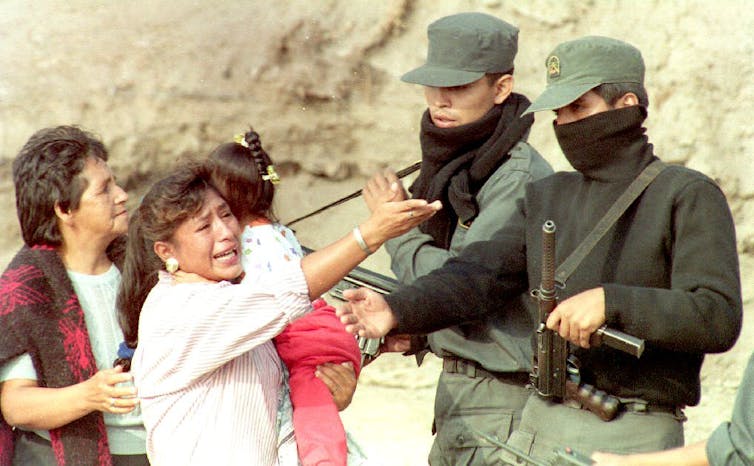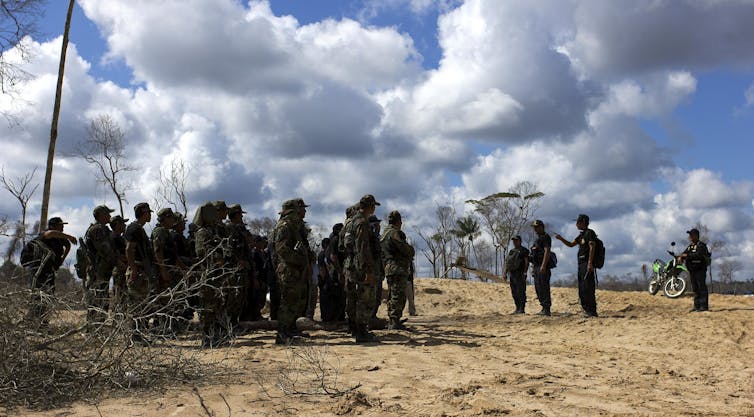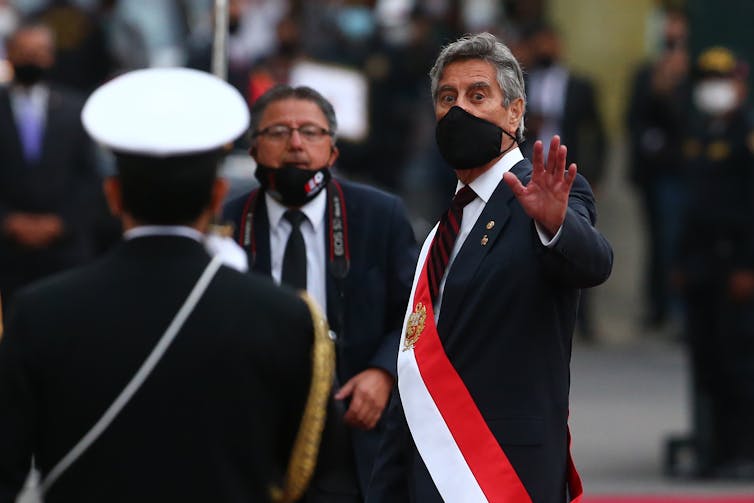Peru's democracy faces greatest trial since Fujimori dictatorship after two presidents are ousted in one week
- Written by Gisselle Vila Benites, Adjunct Researcher at the Center for Mining and Sustainability Studies at the Universidad del Pacífico (Peru) and PhD Candidate in Geography, University of Melbourne
Peru’s new interim president took office on Nov. 17 under unenviable circumstances[1].
Francisco Sagasti became the South American country’s third president in a week after President Martin Vizcarra was impeached for “moral incapacity[2]” in what many Peruvians saw as a coup by Congress[3]. Then Vizcarra’s successor, congressional president Manuel Merino, was quickly forced to resign after furious public protest.
New president Sagasti must now steer a shaken nation not just toward elections, scheduled for April 2021, but also toward renewed faith in democracy.
It’s not an unprecedented mandate for a Peruvian leader. Exactly 20 years ago, Peru’s political leaders faced – and ultimately failed – a similar test, after the fall of dictator Alberto Fujimori[4].
And their failures explain why Peru, in the words of political scientist Alberto Vergara[5], peered into the “abyss” of repressive authoritarianism for six days this November – with protesters facing indiscriminate and deadly violence,[6] even kidnapping, torture, illegal detention[7] and sexual abuse[8] by Peruvian police.
Great expectations fall short
During Fujimori’s corrupt military-backed rule between 1990 and 2000, Peru’s democratic institutions were dismantled and its democratic values subverted. Dissenters faced death, disappearance and torture[9].
Fujimori’s regime came crumbling down[10] in November 2000 because of electoral fraud and a mass popular uprising[11]. Fujimori was removed from office by Congress[12] and replaced by congressional leader Valentín Paniagua.
As interim president, Paniagua had a mandate – as Sagasti does today – to lead a deeply scarred nation into a formal democratic transition and help society heal. In 2001, Paniagua established a truth and reconciliation commission[13] to document Fujimori’s atrocities and created a constitutional commission tasked with identifying the structural changes required to safeguard Peruvian democracy in the future.
Paniagua’s successors did not see his initiatives through.
The truth commission meticulously documented state crimes, and in 2009 Fujimori was convicted of mass human rights abuses[14]. But prosecutions of others and redress for victims – particularly poor, rural and Indigenous populations – have been excruciatingly slow and inadequate[15].
 Confrontations with security forces, like this 1992 encounter outside a Peruvian prison, were a feature of life under Fujimori.
Roberto Schmidt/AFP via Getty Images[16]
Confrontations with security forces, like this 1992 encounter outside a Peruvian prison, were a feature of life under Fujimori.
Roberto Schmidt/AFP via Getty Images[16]
Peru’s leaders after Paniagua also discarded arguments that Peru needed a new constitution[17] with greater protections for democracy and the rule of law. Drafting a new constitution might have ensured, as the late Peruvian politician Henry Pease[18] put it, that “scoundrels won’t feel free to dissolve the Congress” as Fujimori had.
Instead, Alejandro Toledo, the first democratically elected president after Fujimori, channeled reform demands into 2002’s “National Agreement[19].” This document, developed jointly by government, civil society and political parties, laid out the basis for Peru’s democratic transition and established a shared national vision.
But it did little to tackle Peru’s chronic governance problems. Social, environmental and accountability controls over public and private investment remained weak. So did Peruvian courts, which are vulnerable to special interests because of a politicized and often corrupt judicial appointment process[20].
Uneven growth
The consequences of Peru’s lack of reform were dramatically revealed in recent years in the Lava Jato[21] corruption scandal, in which construction companies bribed politicians across Latin America to snag big government contracts.
Since 2016, four Peruvian presidents and Fujimori’s own daughter have been criminally implicated in Lava Jato. Vizcarra, whose impeachment set off Peru’s current political crisis, became vice president because of this long-running scandal. He came to power in 2018 when then-president Pedro Pablo Kuczynski resigned after accusations of bribery[22].
But when lawmakers ousted President Vizcarra with the same charges in November 2020, it caused immediate public condemnation. Protesters felt lawmakers’ interpretation of “moral incapacity” – a clause in the Peruvian constitution – was dubious at best[23]. At worst, they feared, it was a cynical manipulation by congressional conservatives to seize Peru’s government.
When Vizcarra’s successor, Merino, appointed as his prime minister politician Antero Flores-Araoz[24] – an ally of congressional extreme right-wingers – those fears seemed to be confirmed. Some 2.7 million Peruvians – almost one-tenth of the population – took to the streets[25]. Merino resigned after six days, having failed to secure the military’s support.
 Performance artists commemorate the victims of police killings during November’s protests.
Carlos Garcia Granthon/Fotoholica Press/LightRocket via Getty Images[26]
Performance artists commemorate the victims of police killings during November’s protests.
Carlos Garcia Granthon/Fotoholica Press/LightRocket via Getty Images[26]
Today, 85% of Peruvians surveyed by the Vanderbilt University pollsters Latinobarometro agree that Peru “is ruled by a handful of powerful groups for their own benefit[27]”. The country loses about US$6.5 billion to corruption every year[28], according to the national comptroller.
Still, Peru’s economy has boomed since 2000, fueled primarily by mineral extraction, gas and crops like asparagus, grapes and avocados[29]. Mining accounts for about 60% of exports[30].
While these activities occur in rural areas, Peru’s countryside remains extremely poor[31]. People in gold-rich Cajamarca are about five times more likely to live in poverty than those in metropolitan Lima.
 Peruvian National Police at an illegal gold mine near Puerto Maldonado, June 11, 2013.
Lig Ynnek/flickr, CC BY-NC[32][33]
Peruvian National Police at an illegal gold mine near Puerto Maldonado, June 11, 2013.
Lig Ynnek/flickr, CC BY-NC[32][33]
Peruvians who protest against the environmental damage[34] and disruption of livelihoods[35] caused by mining – both legal and illegal – are often met with police and security force violence[36].
Protests and legal battles over mining in Peru have earned little political response. Oversight of mining operations is so weak that police and military forces sometimes sign agreements with companies to protect mines[37] from protests.
Sagasti’s task
Improving political and economic inclusion and reforming the police are now high on Peruvian protesters’ list of demands.
 President Francisco Sagasti after taking his oath of office Nov. 17.
Hugo Curotto/Getty Images[38]
President Francisco Sagasti after taking his oath of office Nov. 17.
Hugo Curotto/Getty Images[38]
As in 2000, some protesters and politicians are again calling for a new constitution[39] that will strengthen the separation of powers in Peru[40] and hold elected officials more accountable for their actions.
[Deep knowledge, daily. Sign up for The Conversation’s newsletter[41].]
Back in the 2000s, Congress neglected such structural changes[42], allowing the problems that gave rise to Fujimori’s regime to continue after his overthrow.
Today Peru’s vigilant young protesters expect[43] Sagasti to do more. To succeed as a post-crisis leader, he’ll need to restore Peruvians’ trust in government and lay the foundation for a more democratic future.
References
- ^ unenviable circumstances (www.americasquarterly.org)
- ^ moral incapacity (www.dw.com)
- ^ coup by Congress (iep.org.pe)
- ^ after the fall of dictator Alberto Fujimori (www.msn.com)
- ^ political scientist Alberto Vergara (fb.watch)
- ^ indiscriminate and deadly violence, (derechoshumanos.pe)
- ^ kidnapping, torture, illegal detention (convoca.pe)
- ^ sexual abuse (rpp.pe)
- ^ faced death, disappearance and torture (www.law.ox.ac.uk)
- ^ came crumbling down (www.wsws.org)
- ^ mass popular uprising (www.hrw.org)
- ^ removed from office by Congress (www.aparchive.com)
- ^ established a truth and reconciliation commission (www.cverdad.org.pe)
- ^ convicted of mass human rights abuses (digitalcommons.wcl.american.edu)
- ^ excruciatingly slow and inadequate (idehpucp.pucp.edu.pe)
- ^ Roberto Schmidt/AFP via Getty Images (www.gettyimages.com)
- ^ discarded arguments that Peru needed a new constitution (www.elsevier.es)
- ^ Henry Pease (www.google.com)
- ^ National Agreement (www.acuerdonacional.pe)
- ^ judicial appointment process (www.revistaideele.com)
- ^ Lava Jato (nyujlpp.org)
- ^ resigned after accusations of bribery (www.theguardian.com)
- ^ was dubious at best (www.dw.com)
- ^ politician Antero Flores-Araoz (andina.pe)
- ^ took to the streets (www.ipsos.com)
- ^ Carlos Garcia Granthon/Fotoholica Press/LightRocket via Getty Images (www.gettyimages.com)
- ^ is ruled by a handful of powerful groups for their own benefit (www.latinobarometro.org)
- ^ loses about US$6.5 billion to corruption every year (rpp.pe)
- ^ crops like asparagus, grapes and avocados (oxfordbusinessgroup.com)
- ^ 60% of exports (www.gob.pe)
- ^ countryside remains extremely poor (peru.oxfam.org)
- ^ Lig Ynnek/flickr (www.flickr.com)
- ^ CC BY-NC (creativecommons.org)
- ^ environmental damage (www.taylorfrancis.com)
- ^ disruption of livelihoods (www.sciencedirect.com)
- ^ police and security force violence (perusupportgroup.org.uk)
- ^ sign agreements with companies to protect mines (earthrights.org)
- ^ Hugo Curotto/Getty Images (www.gettyimages.com)
- ^ calling for a new constitution (www.youtube.com)
- ^ strengthen the separation of powers in Peru (elpais.com)
- ^ Sign up for The Conversation’s newsletter (theconversation.com)
- ^ such structural changes (www2.congreso.gob.pe)
- ^ Peru’s vigilant young protesters expect (www.pagina12.com.ar)
Authors: Gisselle Vila Benites, Adjunct Researcher at the Center for Mining and Sustainability Studies at the Universidad del Pacífico (Peru) and PhD Candidate in Geography, University of Melbourne


